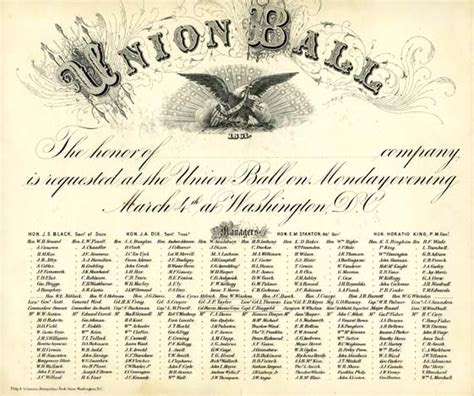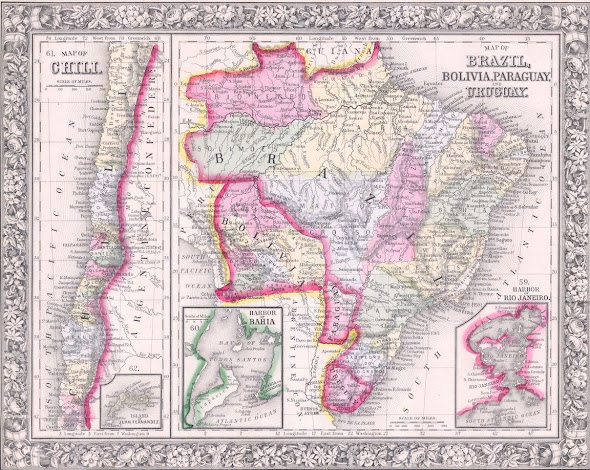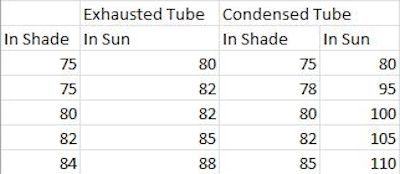Mr. Lincoln's Party & Food Fight
The Lincoln’s knew how to throw a party. Abraham Lincoln’s second Inaugural Ball took
place March 4, 1865, the evening after he had been sworn into office for a
second term. (It was not until the 1930s that the inauguration of presidents
was changed to January.) Counting the ticket sales and the formal invitations four
thousand people attended the ball. The
event was a spectacular success and a spectacular mess.
The government patent office was the only building large
enough for the event. Now, you may wonder
why the Patent Office had such a huge building.
Well, it’s because they had to store and display the thousands of models
required of each patent filed. Don’t ask me what the Patent Office did with the
models to make room for the ball.
Newspapers in the big cities, Washington, New York, and
Philadelphia wrote similar reports of the event. I have chosen to reproduce the
account from the Washington Evening Star.
The inaugural ball touches so many areas of interest, that I have followed the
newspaper reporter’s approach to divide the events into sections. Who wore what? who was there? and with whom?
how was the food? How many bands? How much dancing? How did you get home?
Dining became a spectacular food fight of sorts—and that
doesn’t count the police intervening in a food fight the chefs had among
themselves. And Uber was long ago preceded by the local cab drivers—called
johns—taking advantage of the time and weather by adjusting rates upwards.
Many of the most important people did not come in a hack—a
cab—they came with their own coach and team.
Imagine the chaos of valet parking when it involves both the coach, coachmen,
and the horses. And it had rained heavily for two days prior.
Ironically, this was the same date that the mayor of DC
announced Congress had finally allotted funds to start paving streets in the
capital.
An excerpt from the Washington Evening Star's account
the full account is below the pictures of the dancing and a ball ticket for $10
The onset of the crowd upon the tables was frightful, and
nothing but the immense reserves of eatables laid in by a thoughtful supper
committee would have supplied the demand, or rather the waste. Numbers who
could not find immediate room at the tables, colonized in the numerous alcoves,
where they were catered for by some of their number, who, with more audacity
than good taste, could be seen snatching whole pates, chickens, legs of veal,
halves of turkies (sic), ornamental pyramids, etc., from the tables, and
bearing them aloft over the heads of the shuttering crowd, (ladies especially,
with greasy run to their dresses impending,) carry them off in triumph for
private deleciation (sic).
The floor of the upper room was soon sticky, pasty, and oily with wasted confections, mashed cake and debris of fowl and meat. The alcove appropriators of eatables from the table left their plates upon the floor after a free and easy sort, miscellaneously or in chance piles, adding to the difficulty of locomotion; and gentlemen, in consciously giving a wide berth to a lady’s skirt, not infrequently steered clear of Scylia only to fall upon a Charydibos(sic) of greasy crockery.
BILL OF FARE
THE INAUGURAL BALL
March 6, 1865,
Washington, DC
Washington Evening
Star March 7, 1865, page 2
Unquestionably, the ball last night
in most essentials surpassed any previous affair of the sort since inauguration
balls were inaugurated. There was first an unsurpassed room and series of rooms
for the purpose. Such another magnificent ballroom, supper room, promenade,
hall, and series of apartments for the refreshment rooms, dressing rooms, cloak
rooms, etc., were probably never before found in conjunction under one roof.
Floor plan of the Patent Building
The opportunity for dress display
in such spacious and brilliantly lighted halls was necessarily unsurpassed and
the coup d’ oeil from the elevated seats lining the dancing hall at any
time from 10:00 P.M., until daylight, was brilliant in the extreme.
The arrangements by the management
were thoughtful and on a liberal scale. Three bands were provided, Withers’ Band
for the dancing, Lilie’s Finley Hospital Band for the Promenade Music, and the
band of the Ninth Veteran Reserve Corps for the supper room.
The decorations for the various
rooms had been placed in artistic hands, and the result of the harmonious
blending of colors was very pleasing to the eye, and especially in conjunction
with the brilliant effect from the richly dressed assemblage.
The ballroom was the long north
hall of the Patent Office, used heretofore on some special occasions for balls
and concerts for patriotic purposes. The floor is laid in marble tiles of blue
and white, forming, not quite so elastic a material as desirable for dancing
purposes, but as the needs of a whole ballroom on such an occasion as last
night is mainly for promenade purposes, it answered the requirements admirably.
And was less objectionable on the score of dust than a wooden floor. The
arrangement of the gas jets in lines across the wall below the ceiling was such
as to distribute the light with excellent effect, for which judicious
arrangement the managers received the special thanks of the ladies, who after
taking pains to dress with proper care for such an occasion naturally abhor and
detest and ill lighted ball room.
The dancing commenced shortly
before ten o’clock and in the course of the night the following programme was
gone through with:
PROGRAMME
National Inauguration March—Composed expressly for the occasion.
Quadrille—Catharina H. Bliss. Lancers –Horse Guards; Julien, 3, Waltz and
gallop—Kathleen Mayour. Quadrille—Sylvester:
Ab. Leutner. Schottische and varsovienne—Josephine and Amelia: Ab: Leutner. 6, Lancers—Farvenia: Ab Leutner. 7, Polka redowa and Waltz—Celest and
Medora: Ab Leutner. 8, Quadrille—Luxus; Ab. Leutner. 9, Lancers—Capitol:
Ab Leutner. 10, Waltz and Polka—Canary Bird and Jeannie; Wm. Withers,Jr. 11 Quadrille –Frei Kugeln; Von
Weber. 12, Danish Polka and gallop—Danishand Ledernier mo: Labitzky. 13,
Lancer Bon ton: Labitzky. 14, Walz and Schottische—Die Presburger and Josephine;
Labitzky. 15, Quadrille (Basket) –Popular Aires. 16, Polka redowa and varsovienne—Charlotte
and Louise 17, Lancers—Washington. 18, Galop and Waltz—Die Provinzlialen and
Emma. 19, Quadrille—Faust—Gounod. 20, Lancers—Cavalry. Virginia Reel—Break Down
Between ten and eleven o’clock the
military band struck up “Hail to the Chief,” indicating the approach of
President Lincoln and party, and on their arrival a path was made for them
through the throng to a dais at the center of the north side of the hall.
The distinguished party was introduced
by Messrs. Clephane and French of the managers. The President came in
accompanied by Speaker Colfax, and Mrs. Lincoln was escorted by Senator Sumner.
The position occupied by the Presidential party was necessarily the center of
attraction during the time they were in the room, and the dancers were obliged
to accommodate themselves to the movement in that direction.
Mrs. Lincoln was attired in
admirable taste. She wore a white silk skirt and bodice, an elaborately-worked
white lace dress over the silk skirt, a berthe of point lace and puffs of silk,
and a white fan trimmed with ermine and silver spangles, white kid gloves and
lace handkerchief, and a necklace, bracelets and earrings of pearls. Her hair
was brushed closely back from her forehead, and a head-dress, composed of a
wreath of white jessamines and purple violets, with long trailing vines,
completed a most recherche costume.
The President was dressed in black,
with white kid gloves.
Other distinguished personages made
their appearance about the same time—Secretaries Seward, Welles, Dennison,
Usher, Attorney General Speed, and a goodly representation of the diplomatic
corps.
General Halleck was present, as also General Banks, General
Hooker (escorting Miss Chase, daughter of Chief Justice Chase,) Admiral
Farragut, and many others of military note.
Long John Wentworth towered above
the assemblage, and since his last appearance here has grown stout as well as
long. (A tall man, Wentworth was one of the prominent businessmen of his day)
George Francis Train, who was
amongst the throng, has also increased in bulk lately, despite a restless
career, not well calculated for the accumulation of adipose matter. But George
is a superb looking fellow, fat or lean, and himself and his beautiful wife
(who in the opinion f many was the best dressed woman in the room) attracted
attention wherever they moved. (Like Wentworth, Train was a well known businessman.)
Mrs. Southworth, the novelist, was
present, accompanied by her son, a talented young student at New York
University.
Captain Robert Lincoln, now on General
Grant’s staff, was in the ballroom for a considerable portion of the evening,
and escorted the beautiful daughter of Senator Harlan.
Lieutenant Cushing, of the navy,
the hero of torpedo exploits, was present, and was made much of by the admirers
of grit and heroism.
An illustration of some of the ball gowns
The dress display was rich and varied,
New York belle-dom taking the lead in this department, though Washington (perhaps
dividing honors with Philadelphia) carried off the palm for beauty.
Many of the dresses were made high
with short sleeves, and long sleeves of puffed tulle worn over them. Others
formed simply a bodice, festooned in front over waist, and sleeves of tulle.
One, a superb blue and silver
fabric, was trimmed with costly point lace and rich cord with silver tassels.
The head-dress consisted of blue velvet, with lace lappets and diamond
aigrette.
Another dress attracting much
attention, was of white glace silk, puffed to the knee with tulle, put on in
diagonal lines, and ornamented with white satin ribbon, rosebuds and
crystallized grass. A tunic of lace draped the bodice, which was also trimmed with
puffings, and was looped up on one side with full bouquet of grass, rosebuds,
and loops and ends of white satin. White satin ribbon passed through the hem
formed a border to the tunic, which was deep behind but short in front.
A dress followed avidly by many female
eyes, consisted of black tulle, embroidered in gold colored silk, in small wheat
ears. It was made over black satin, and trimmed with gold fringe round the
bottom of the skirt, and long sash ends. The body was low, and crossed in folds
from right to left, the fringe forming an order. The ornaments consisted of
gold wheat and crimson poppies, placed upon the right shoulder and left side of
the waist, and these also formed the head dress.
Corn colored and lilac silks
appeared to be in especial favor.
Among the great number of rich
costumes was a pearl colored silk, trimmed with a deep flounce of white lace, a
white lace berthe and basque trimmed with narrow white lace, and
head dress of purple violets and fine white flowers A maroon colored velvet
dress, made high in the neck, trimmed with square pearl buttons, with long basque
and a handsome white lace shawl. A pink India silk with narrow bars made low in
the neck, with short sleeves and a long pointed bodice a point lace berthe
and white lace shawl, with jewelry of opals and pearls. ( a basque is a very tight corset and bodice. I cannot find what a berthe was.)
Miss Stoops appeared as the Goddess
of Liberty, with Cap of Liberty and Spangled Skirt.
Shortly after midnight the
Presidential party were escorted to the supper room, and when they were duly
placed at the head of the table the doors were thrown open for the assemblage
at large. The scene presented at the supper table prior to the descent of the hungry
crowd was very attractive as well as appetizing. The tables were some 250
feet in extent and ornamented in the
highest style of the confectioner’s art, and these ornaments were flanked by
such edibles as noted in the following bill of fare:
BILL OF FARE
The center
ornament was a model of the Capitol in a style of elaboration we never before
saw attempted in such material.
Upon the
sides of the pedestal upon which the model was mounted were devices, as follows:
Upon the
east front, a representation of Fort Sumter as it appeared when recently taken possession
of by Union troops; iron clads at a short distance, and small boats at the
base, from which troops have apparently just landed, who are re-erecting the flag
of the Union.
Upon the
west front, the Revolution of 1776—as emblematized by Washington and his
generals in counsel in the field; on one hand the Goddess of Victory and Peace,
and on the other a figure of Liberty, clothes with the rays of the rising sun,
and crushing slavery and the serpent of secession beneath her feet.
Upon the
north wing, the Progress of Civilization, as shown by the advance of the white
man upon this continent, and the retiring, in attitudes of wonder and awe, of
the aborigines.
Upon the south wing, the Year 1865—a grouping, with
excellent effects, of various products of literature, the arts and sciences,
and the most prominent emblems of wonder-working civilization of the present
day, which evidences most strikingly the remarkable progress of our nation
during the comparatively brief period of its existence.
The
piece towards the head of the table was a monument in honor of the army,
representing height upon height of victories gained an immortal honors 1, each
successive gradation covered with beautifully executed and distinctively
representative. Insignia of war of every variety. Among these representations
were six devices: The national colors and other Insignia of war; Scout skirmishing;
A general riding at the head of an advancing column, with Fieldglass and active
use; A close combat between infantry and cavalry; the capture of batteries and
field artillery by infantry; And a quiet and well-illustrated camp scene.
These
were surmounted with three crests, upon which were Eagles, bearing in their
beaks the following significant mottos: “The Union must and shall be
preserved.” Andrew Jackson. “Eternal vigilance is the price of liberty.” Thomas
Jefferson. “We shall nobly save or meanly lose the last best hope of the human
race,” Abraham Lincoln.
Upon the
pedestal beneath were photographed portraits of Lincoln, Halleck, Sherman,
Grant, Thomas and Porter.
The piece to the left of the
center was in honor of The Navy., and was surmounted by Vice Admiral Farragut's
flagship, The Hartford, riding upon a tempestuous sea, and a representation of
the Admiral tied to the mast; And beneath this were six devices. Dash. A
miniature representation of Fort Sumter; Insignia of naval warfare, cannon,
flags and an anchor; liberty, with triumphant mean, beckoning naval heroes
onward and upward, A jolly tar, in full rig, Neptune driving his chariot, with
Trident in hand; In the Insignia of the Coast Survey.
The excellent supper (not only
handsome, but good) was furnished by G. A. Balzer, confectionery of this
city.
Our jolly friend, T. M. Harvey, of oyster renown, was present, superintending the myriad preparations of oysters served upon this occasion.
The onset of the crowd upon the tables was frightful, and
nothing but the immense reserves of eatables laid in by a thoughtful supper
committee would have supplied the demand, or rather the waste. Numbers who
could not find immediate room at the tables, colonized in the numerous alcoves,
where they were catered for by some of their number, who, with more audacity
than good taste, could be seen snatching whole pates, chickens, legs of veal,
halves of turkies (sic), ornamental pyramids, etc., from the tables, and
bearing them aloft over the heads of the shuttering crowd, (ladies especially,
with greasy run to their dresses impending,) carry them off in triumph for
private deleciation (sic).
The floor
of the upper room was soon sticky, pasty, and oily with wasted confections,
mashed cake and debris of fowl and meat. The alcove appropriators of eatables
from the table left their plates upon the floor after a free and easy sort, miscellaneously
or in chance piles, adding to the difficulty of locomotion; and gentlemen, in
consciously giving a wide berth to a lady’s skirt, not infrequently steered
clear of Scylia only to fall upon a Charydibos(sic) of greasy crockery.
Finally,
everyone satisfied, even those who felt bound to “eat their ten dollars’
worth,” and the ball room again filled up and dance
and promenade was resumed.
President
Lincoln and party withdrew about one o’clock, but most of the other
distinguished guests lingered for hours afterwards, and the rooms did not thin
out until the morning was well advanced.
It is estimated that not less than
4000 persons were present at this ball period up to 9:00 o'clock in the
evening. The managers could not judge whether success was assured; that is to
say, a paying success, in view of the great outlay. But by 10:00 o'clock the
surge of arrivals showed that it was not only to be successful, but a great
success.
The scene from the upper steps of
the Patent Office, (South front,) as the ball was “letting out,” was unique.
Powerful lights from reflectors threw a glare for many squares in every
direction. Anyone curious to know Washington's available resources in the way
of hacks could there learn. They were there by the acre, and as far as the eye
could reach.
One gentleman, who was inquiring
anxiously for his carriage (number somewhere up among the thousands) was
informed facetiously by some of the Johns that his vehicle was somewhere in the
vicinity of the Treasury Department, and would probably be able to work its way
up to the Patent Office in the course of the forenoon!










Comments
Post a Comment